To make the best oil-preserved bell peppers, you'll want to start with firm, uniformly colored peppers without blemishes. Red and white varieties offer the sweetest flavor profiles. Roast your peppers at 500°F until blistered, then peel and slice them into uniform pieces. Layer them in sterilized glass jars with fresh garlic, thyme, and your choice of seasonings. Pour heated olive oil (200°F) over the peppers, ensuring they're completely submerged. Store properly sealed jars in the refrigerator for up to 4 months. For the longest shelf life, add preservatives like citric acid or vinegar. There's much more to mastering this preservation technique than meets the eye.
Fresh Peppers Selection Guide
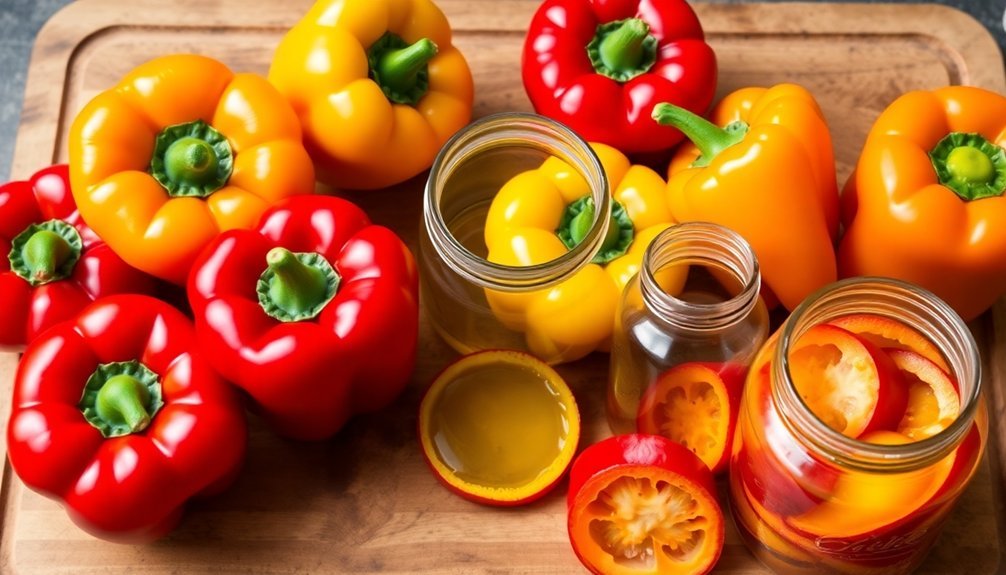
For ideal preservation results, select peppers with consistent coloring and avoid those with dark spots or discoloration.
Look for peppers that have firm, wrinkle-free skin, as wrinkled skin indicates spoilage.
The flesh should be crisp and sturdy, never flimsy or slimy.
Remember that each pepper variety brings its own unique flavor – red and white peppers are sweetest, while green ones offer a slightly bitter note that some prefer for preserving.
Basic Oil Preservation Method
Once you've selected your perfect peppers, the oil preservation process begins with proper preparation and careful attention to temperature control. Start by preheating your broiler to 500 degrees and roasting the peppers until their skin blisters and blackens.
After cooling them covered for 20 minutes, you'll need to peel, deseed, and slice them. Each pepper should be cut into 4 to 5 slices.
You'll want to prepare your sterilized canning jars by placing fresh garlic slices at the bottom. Layer your prepared pepper slices and additional garlic in the jars, ensuring you're leaving enough space for proper oil circulation. Don't pack the peppers too tightly, and maintain a few inches of headspace at the top.
Heat pure olive oil (not extra virgin) to 200°F in a heavy-bottomed saucepan. Carefully ladle the hot oil into your jars until the peppers are completely submerged. Use a plastic skewer to remove any trapped air bubbles, ensuring total pepper coverage.
Seal the jars with sterilized lids and let them cool for an hour before refrigerating. With proper storage in the refrigerator, your oil-preserved peppers will last 3-4 months.
Remember to check periodically and add more oil if needed to maintain coverage.
Safety Precautions When Preserving
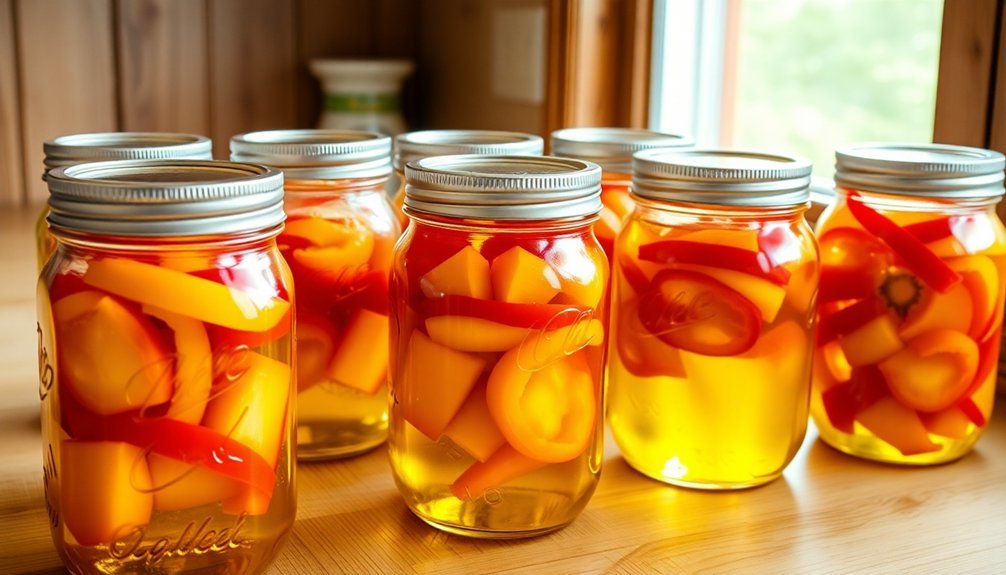
To protect yourself from botulism when preserving bell peppers in oil, you'll need to follow strict safety protocols since the low-acid environment can harbor dangerous bacteria.
You must store your oil-preserved peppers in the refrigerator and use them within four days, or freeze them for longer storage.
Don't skip proper sterilization of your jars and equipment, as this critical step helps prevent bacterial growth and guarantees your preserved peppers remain safe to eat.
Always use glass containers for storage since plastic is not suitable for preserving peppers in oil long-term.
Prevent Botulism Risk
Safety measures against botulism demand critical attention when preserving bell peppers in oil. Since C. botulinum spores naturally exist in vegetables and thrive in oil's oxygen-free environment, you'll need to follow strict guidelines to prevent toxin formation.
| Risk Factor | Why It's Dangerous | Prevention Method |
|---|---|---|
| Anaerobic Environment | Oil creates oxygen-free conditions perfect for bacteria | Don't store peppers in oil long-term |
| pH Level | pH above 4.6 supports toxin growth | Use commercial acidifying agents |
| Temperature | Room temp accelerates bacterial growth | Refrigerate immediately |
| Time | Extended storage increases risk | Consume within 10 days |
| Contamination | Soil particles carry spores | Clean peppers thoroughly |
You can't rely on refrigeration alone to prevent botulism, as spores can still produce toxins at low temperatures over time. Don't assume that oil preserves your peppers – it actually creates ideal conditions for bacterial growth. Commercial acidifying agents are essential for safe preservation, but these aren't readily available for home use. If you're making oil-preserved peppers at home, store them in the refrigerator and consume them within 10 days. Never eat from containers that show signs of spoilage, like bulging or unusual odors.
Safe Storage Requirements
Building on proper botulism prevention, storing oil-preserved bell peppers requires specific conditions and methods to maintain both safety and quality.
You'll need to take into account both short-term and long-term storage options to guarantee your preserved peppers remain safe to eat.
For short-term storage up to two days, you can keep your peppers in plain oil. However, if you're planning to store them longer, you must add preservatives like vinegar or salt to prevent bacterial growth.
Make sure you're using airtight containers and submerging the peppers completely in the oil mixture, removing any air bubbles with a chopstick.
You'll need to refrigerate your preserved peppers promptly after preparation. Cool them first to prevent condensation, then store them in a sealed container in your refrigerator for up to three months.
Check the seals regularly to maintain safety.
For the longest storage life, transfer your oil-preserved peppers to freezer bags or containers and freeze them flat.
This method extends shelf life up to a year and better maintains the peppers' texture and flavor compared to long-term refrigeration.
Proper Storage Techniques
You'll need to store your oil-preserved bell peppers at proper temperatures, keeping them refrigerated at 40°F or below to prevent bacterial growth.
Make sure your jars remain completely airtight, with peppers fully submerged in oil and lids tightly sealed to maintain freshness.
Check your preserved peppers regularly for any signs of spoilage, such as mold, off-odors, or changes in color, and discard immediately if you notice any concerning changes.
Maintain Safe Temperatures
Proper temperature control stands out as the most critical factor in preserving bell peppers in oil. You'll need to refrigerate your oil-preserved peppers to prevent bacterial growth and food-borne illness, where they can last up to three months.
While the olive oil may solidify in the fridge, it'll return to liquid form at room temperature. Always keep your peppers fully submerged in oil and check regularly for any signs of spoilage.
For longer storage, you can freeze your peppers in oil for up to a year. Transfer them to a zipper-top bag, ensuring they're in an airtight container to prevent freezer burn.
You'll find that freezing doesn't markedly impact the peppers' nutritional value, and you can use them directly in recipes after thawing.
Don't store your peppers in oil at room temperature, as this increases the risk of botulism and other food-borne illnesses.
To enhance safety, add vinegar or salt to increase acidity levels and inhibit bacterial growth. If you're not using these additives, consider pressure-canning your peppers.
Keep Jars Airtight
Maintaining airtight seals on your storage jars creates the foundation for successfully preserving bell peppers in oil.
You'll need to start with glass jars specifically designed for food storage and guarantee they're properly sterilized through boiling. When filling your jars, leave a quarter-inch headspace at the top and remove any air bubbles using a non-metallic spatula for a secure seal.
Once you've filled the jars, place sterilized seals over the lids and secure them with wire clasps. Process the jars in a boiling water bath for 30 minutes to create a vacuum seal. Don't retighten the lids after cooling, as this can compromise the seal. You'll know you've achieved a proper seal when the center of the lid is indented.
For enhanced preservation, you can use a FoodSaver vacuum sealer to remove additional air from your containers.
Store your sealed jars in a cool, dark place and label them with contents and storage dates. Check your jars regularly to guarantee the seals remain intact and the peppers maintain their quality. If you notice any compromised seals or unusual changes, remove those jars from storage immediately.
Monitor For Spoilage Signs
A critical step in preserving bell peppers in oil is monitoring for signs of spoilage through regular inspections. You'll need to check your preserved peppers frequently, looking for any visual changes that could indicate deterioration.
Watch for discoloration, dark spots, or any fuzzy patches in green, white, or black, as these are clear signs of mold growth.
Pay close attention to the texture of your preserved peppers. They should remain firm and maintain their shape – if you notice they've become soft, wrinkled, or slimy, it's time to discard them.
The oil and brine should stay clear or slightly cloudy; excessive cloudiness with floating particles suggests contamination.
Don't forget to use your nose as a reliable detection tool. Your preserved peppers should maintain a pleasant, slightly sweet aroma.
If you detect sour, fermented, or unusually pungent smells, don't take chances – dispose of them immediately.
Remember, consuming spoiled peppers can lead to serious health issues, including food poisoning with symptoms like nausea, vomiting, and diarrhea.
In rare cases, improperly preserved peppers can even harbor dangerous bacteria like Clostridium botulinum.
Flavoring Your Preserved Peppers
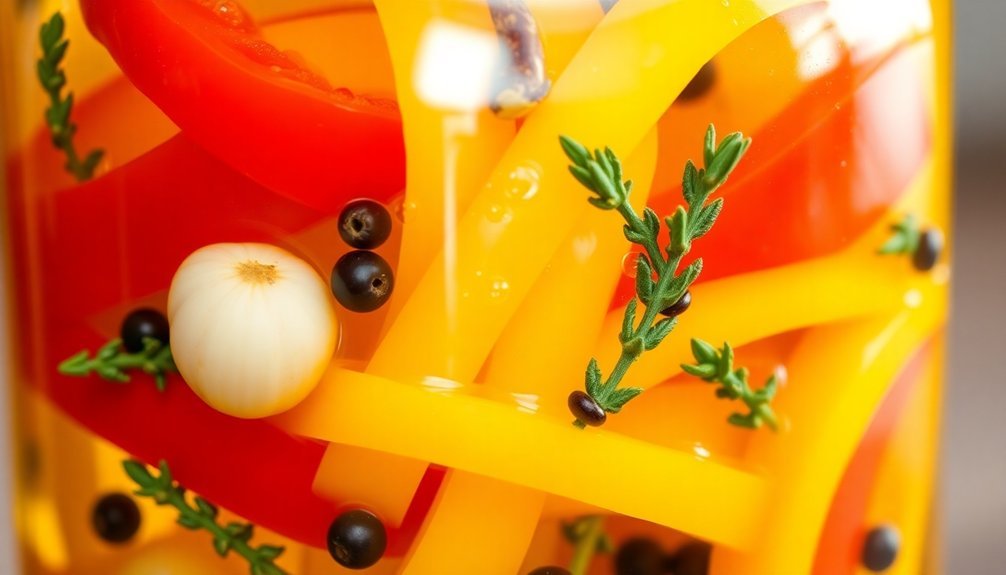
When preserving bell peppers in oil, the right combination of flavoring ingredients transforms them from simple vegetables into delectable antipasti. You'll want to start by roasting both your peppers and garlic, as this process brings out their natural sweetness and creates a more complex flavor profile.
Layer your peppers with fresh thyme, roasted garlic, and seasonings in your storage jars. You can create a robust marinade by combining olive oil with sea salt, black pepper, and chili flakes for heat. For added dimension, include chopped onions, prepared horseradish, or oregano leaves in your mixture.
Don't forget to incorporate acidic elements like lemon juice or vinegar, which not only enhance flavor but also aid with preservation.
As you pack your jars, use a chopstick to remove air bubbles and guarantee even distribution of flavors. Make sure you're completely submerging the peppers in oil, leaving appropriate headspace at the top.
While you can enjoy your peppers immediately, letting them infuse for a while in the refrigerator will deepen their flavor. Don't worry if the oil solidifies in the fridge – it'll return to liquid at room temperature.
Signs of Spoilage
While properly preserved bell peppers can last for months, knowing how to spot spoilage will protect you from consuming unsafe products. You'll want to check for several visual indicators, including dark spots, green or black patches, and any fuzzy mold growth on the peppers. If you notice the vibrant red color fading to brown or the liquid in the jar becoming cloudy, these are clear warning signs.
Pay close attention to texture changes. Your preserved peppers shouldn't be slimy, mushy, or wrinkled. When you touch them, they should maintain their firmness. If they've become soft or developed an unusual surface texture, it's time to discard them.
Trust your nose – it's one of your best tools for detecting spoilage. Fresh preserved peppers should have a pleasant, slightly sweet aroma. If you detect any sour, fermented, or pungent smells, don't consume them.
Also, check the jar itself for signs of trouble. Bulging lids indicate dangerous gas buildup from bacterial growth, and any jar damage or leakage means the peppers aren't safe to eat. If you spot any of these warning signs, dispose of the peppers immediately.
Serving Preserved Bell Peppers
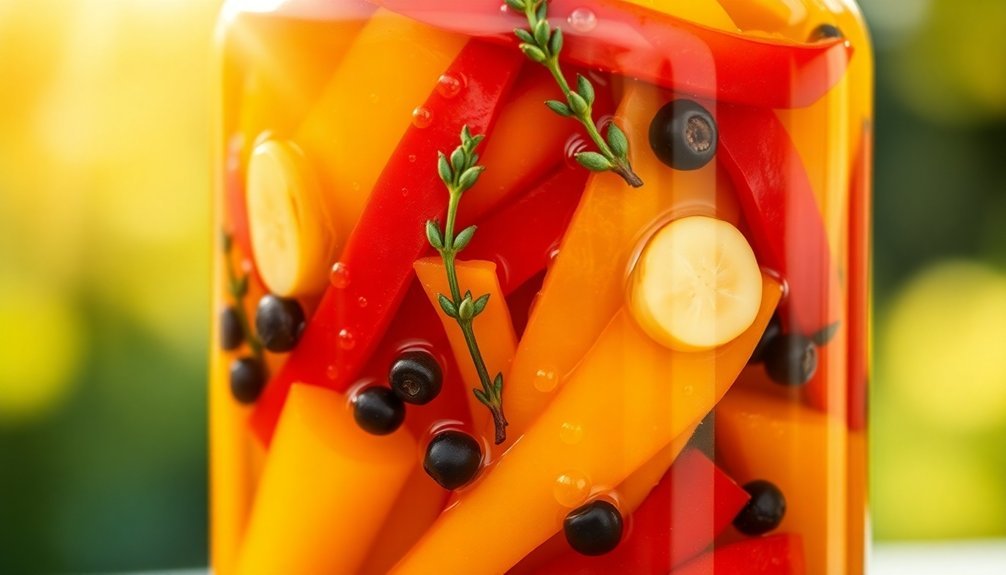
Endless serving possibilities await with oil-preserved bell peppers, making them a versatile addition to your culinary repertoire. You'll find they're perfect as an appetizer alongside various cheeses, particularly provolone, or as a colorful addition to antipasti platters.
For a quick meal, toss them with pasta or layer them on Italian hoagies and sandwiches.
These preserved peppers shine when combined with complementary ingredients. Try pairing them with fresh thyme and chili flakes for added depth, or mix them with roasted garlic for a sweeter profile.
They're excellent in salads, stir-fries, and as toppings for bruschetta or burgers.
For the best presentation, serve your peppers either chilled or at room temperature. If you're storing them in jars, verify they're completely submerged in olive oil and remove any trapped air using a plastic skewer.
Before serving, let refrigerated peppers come to room temperature to restore the oil's clarity. You can serve them straight from the bowl with a fork or arrange them alongside other preserved vegetables for an impressive appetizer spread.
Frequently Asked Questions
Can I Reuse the Oil From Preserved Peppers After Consuming Them?
While you can reuse the oil, it's not recommended due to potential bacterial contamination and moisture content. If you choose to reuse it, make certain it doesn't show signs of rancidity and use it quickly.
Will Different Types of Oils Affect the Preservation Time?
Yes, oil types affect preservation time. You'll get longer storage with pure olive oil due to its stability, while extra virgin olive oil spoils faster. Avoid low smoke point oils for best preservation results.
Does the Size of Pepper Pieces Impact Preservation Quality?
Yes, the size of your pepper pieces matters. You'll get better preservation with smaller, uniform pieces since they're easily covered by oil and allow preservatives to penetrate evenly throughout the food.
Can I Mix Different Colored Bell Peppers in the Same Jar?
Yes, you can mix different colored bell peppers in the same jar. They'll preserve well together and create an attractive presentation. Just make sure you roast and skin them first, then submerge completely in oil.
Should Peppers Be Completely Dry Before Adding Oil?
You don't need completely dry peppers, but you should pat them well to remove excess moisture. Too much water can cause spoilage and affect preservation. Just guarantee they're reasonably dry before adding oil.
In Summary
Now you're ready to enjoy your oil-preserved bell peppers year-round. Remember to always check for signs of spoilage before consuming and store your jars in a cool, dark place. Don't forget that you can get creative with seasonings to make each batch unique. When properly preserved, these peppers will maintain their flavor and texture for up to 12 months, making them perfect for adding to your favorite dishes anytime.

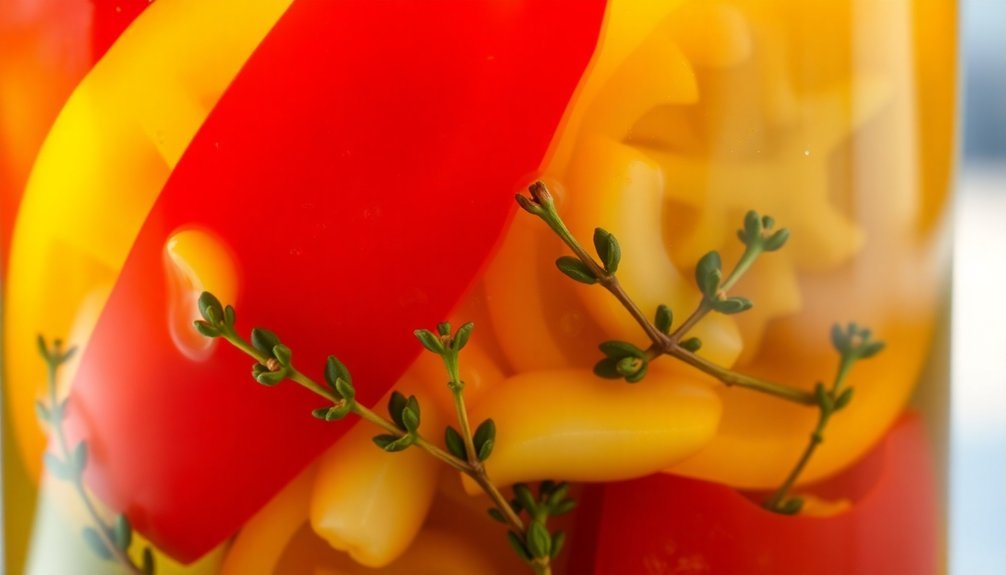



Leave a Reply